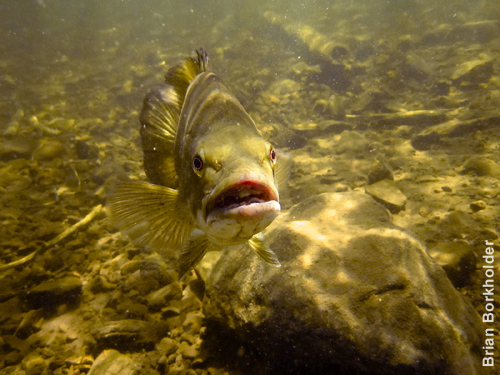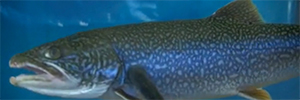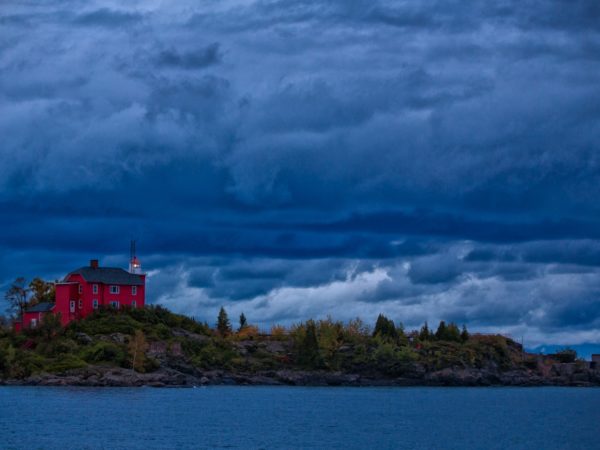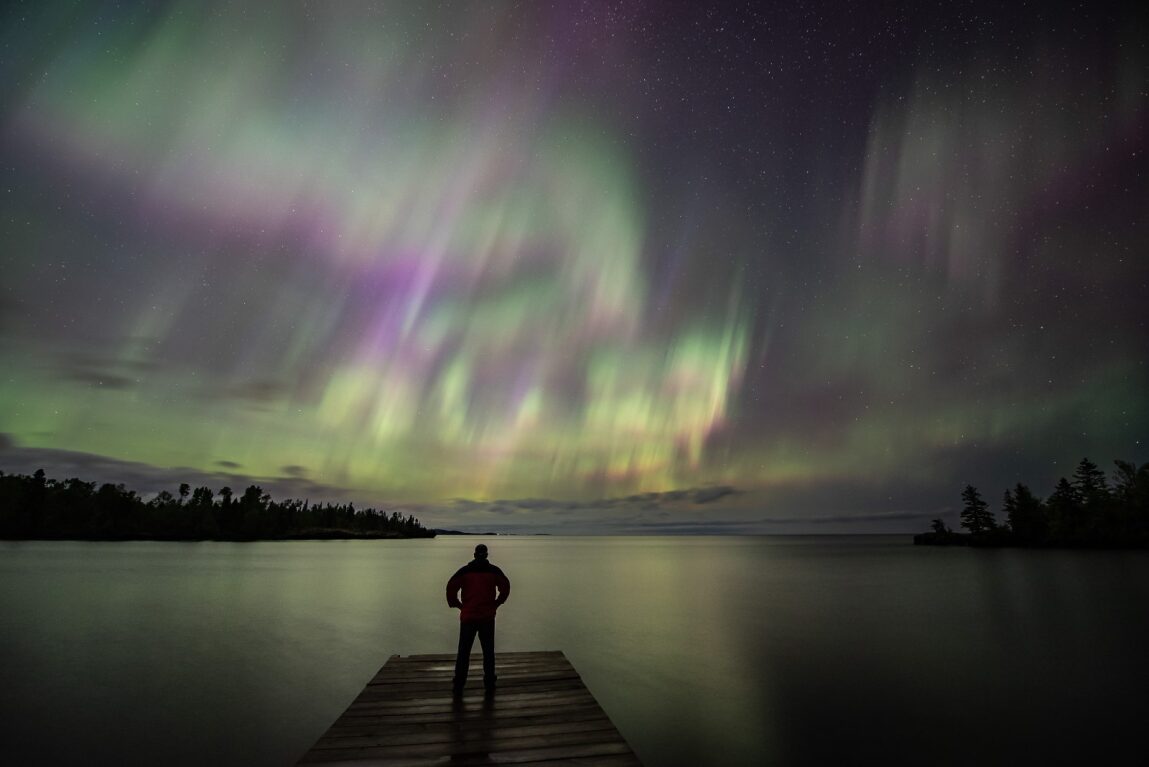
Editor’s Note: “Nibi Chronicles,” a monthly Great Lakes Now feature, is written by Staci Lola Drouillard. A direct descendant of the Grand Portage Band of Ojibwe, she lives and works in Grand Marais on Minnesota’s North Shore of Lake Superior. Her two books “Walking the Old Road: A People’s History of Chippewa City and the Grand Marais Anishinaabe” and “Seven Aunts” were published 2019 and 2022, and she is at work on a children’s story. “Nibi” is a word for water in Ojibwe, and these features explore the intersection of Indigenous history and culture in the modern-day Great Lakes region.
Travis Novitsky is a citizen of the Grand Portage Band of Ojibwe and has been communing with the night sky through his camera lens for over 25 years. “Spirits Dancing: The Night Sky, Indigenous Knowledge & Living Connections to the Cosmos” is a curated collection of his images, in collaboration with Lakota astrophysicist Annette Lee, published last November. The book incorporates a “two-eyed seeing” approach to learning about the cosmos—incorporating Western science along with Indigenous knowledge and ways of knowing. Travis and I talked about stardust, living a good life through the creation of truthful art, and what it’s like to take “a celestial shower.”
“The idea that everything you need is in the stars—that you can just sit quietly under a dark night sky—means there is a great deal of importance in simplicity, in stillness, in taking a celestial shower,” wrote Lee, in a personal story from the book. This cosmic bathing includes breathing stardust—measurable, atomic matter 4.6 billion years old, which literally rains down on earthly things, “even when it’s cloudy.”
Travis Novitsky: Annette is literally talking about cosmic dust, which floats around all the time—we’re inundated with it. We don’t see it. We don’t feel it, but it’s happening. I don’t think that I’m capturing it in the literal sense where you can, you know, make a big print and see all this dust floating in the air. It’s not quite like that. But science has proven that it’s there.
I wondered if Travis sees his work as that of a documentarian, given his ongoing quest to capture historic events that play out in the night sky.
Travis Novitsky: Photography is so many things. You are literally capturing this snapshot in time. I’ve always thought about it in a general sense even before I knew anything about how the Ojibwe viewed the sky historically. My ancestors, 1000 years ago or 2000 years ago–we’re looking at the same stars. To the naked eye Orion looks like Orion did to like my grandpa, right? But if you go back a couple 1000 years, the star spacing was a little different. Astro Bob King in Duluth talks about this. Eventually our constellations as they exist today, and have for as long as we know, are not going to exist anymore. Because space is forever expanding. Somewhere down the line, maybe six or seven generations from now, people will be looking at a different sky.
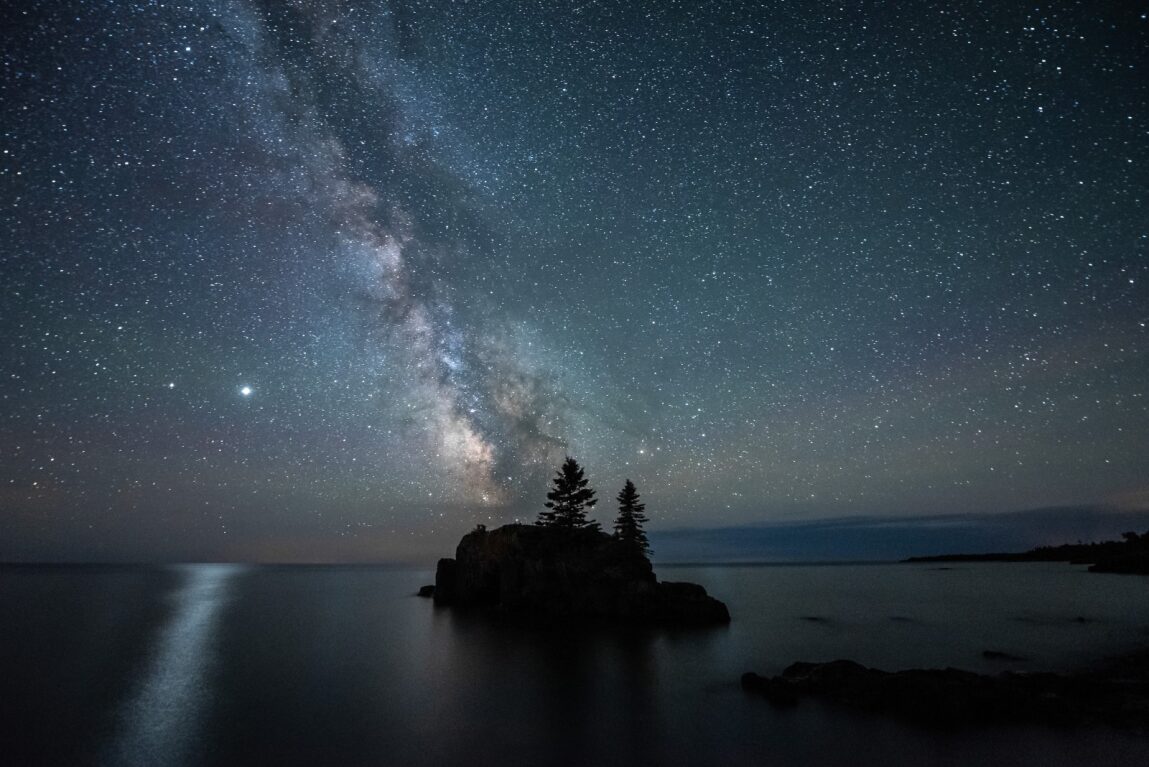
Photo featured in “Spirits Dancing: The Night Sky, Indigenous Knowledge & Living Connections to the Cosmos.” (Photo Credit: Travis Novitsky)
“Spirits Dancing” includes many Indigenous perspectives—Ojibwe, Dakota, Lakota and northern and southern Diné. Each culture has a unique vantage point of the night sky, but unlike mainstream culture, Indigenous cultures share a participatory relationship between the living beings on earth and the sky above. For Travis, this ancestral connection goes deep.
Travis: I first learned from [Ojibwe artist] Carl Gawboy. I spent hours at his place with him looking over his art. And, you know, I brought some of my prints to share with him. Carl tells the story of how the Milky Way is this pathway, or as he calls it, “the river,” of souls, because it’s this pathway to the afterlife. Part of our history as Ojibwe people is traveling by water—we did a lot of traveling by canoe. That was how people got around. It just made sense that it is a river that you would paddle—get in your canoe and embark to the afterlife. He also talks about this fork that goes off the Milky Way, this branch of light that fades out. It’s kind of dark—kind of morbid, but Carl says “if you didn’t live a good honorable life, you would possibly end up going off on that fork and just disappearing into the cosmos and there would be no afterlife for you.” Talk about incentives to live a good life, to be the best person you can be. And when I say that, I don’t mean how modern society tells us to be “successful”—to make a lot of money, acquire a lot of stuff. It’s being humble, kind, generous and having humility. Which, of course, are cultural practices for us generally, as Ojibwe people.
The feeling of paddling a canoe on a river of stars is one Travis has replicated here on earth, but only if the conditions are just right. He explained, ”It has to be incredibly calm, where you can see the stars reflected as points in the water. I have been out in a small 12 foot boat or my kayak, and you get dizzy—I liken it to being out on Lake Superior in the fog, where you don’t know which way is up or down. You just feel like you’re floating there in the universe or within the stars.”
Creative fulfillment and truthful art
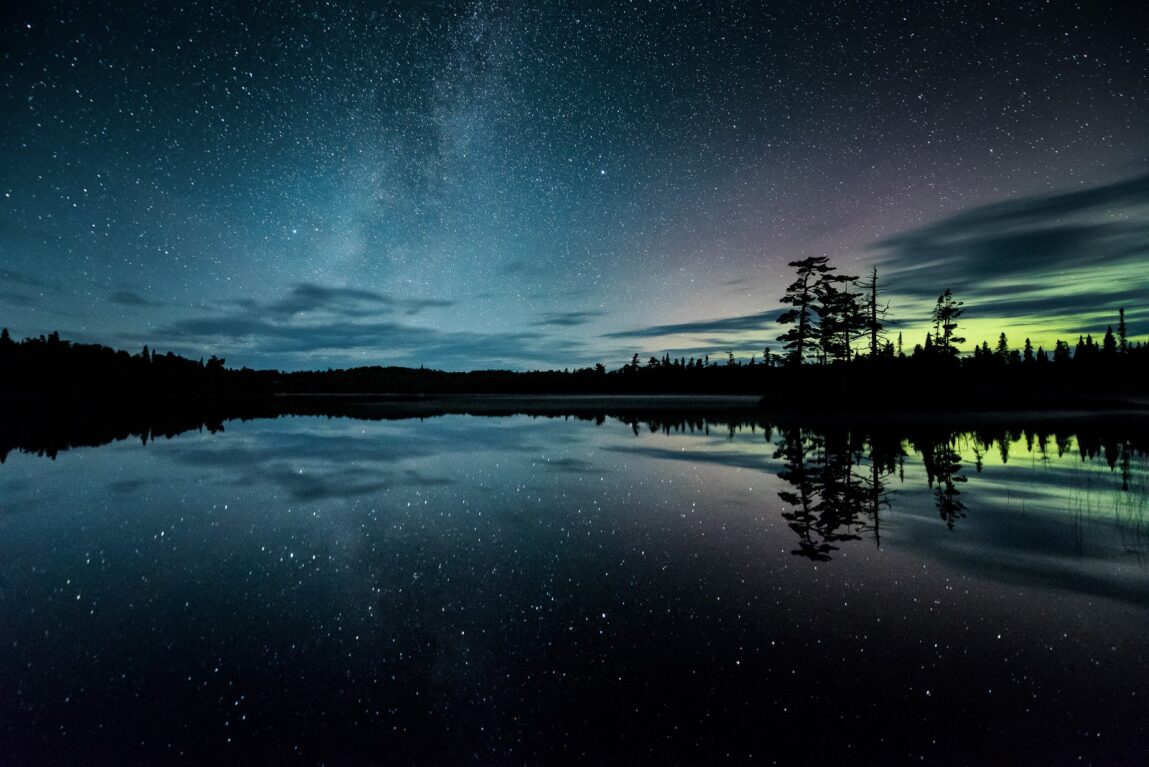
Photo featured in “Spirits Dancing: The Night Sky, Indigenous Knowledge & Living Connections to the Cosmos.” (Photo Credit: Travis Novitsky)
An extraordinary aspect of Travis’s photography is the amount of patience required to create his night sky images. He often spends all night in the field, setting his camera for long exposures, usually 15 to 30 seconds each. He also takes time to review what might be hundreds of images before deciding what to share with the public. Staying true to his subject matter, Travis’s methodical approach is the opposite of what fast-paced mainstream culture expects of artists and instant access to images.
Travis: It’s easy to get caught up in a strong Aurora storm, in the practice of shooting as many photos as you possibly can, because it’s changing so much. So, for a lot of years, I did it that way and it was just exhausting. It wasn’t as fulfilling until I started to slow down and be more intentional about it. The actor Joseph Gordon Levitt said, “if your creativity is driven by a desire to get attention, then you’re never going to be creatively fulfilled.” And it just clicked. I’ve been so driven to create cool images of the Aurora and share them, that I was caught up in that activity, and I wasn’t feeling creatively fulfilled until I started to slow down. And then it came back in a bigger way than I ever thought it would.
Having a participatory relationship with the night sky is acknowledging that we carry a responsibility to witness and protect it. Western science confirms what Indigenous star-watchers have been experiencing since the first street light was illuminated—a growing imbalance between light and dark affects us all, especially nocturnal beings like owls, bats and wild cats, but also human beings.
Travis: There’s a lot of research that look at things like how light pollution affects migration patterns in birds and mammals, even affecting soil composition. And, of course, it affects plant growth. And it affects humans’ circadian rhythms. We’re finding that people who live in large metro areas that never leave the city, and then go to a dark sky area, their eyes aren’t able to adapt to the darkness as well as people who live in rural areas. Their pupils don’t adapt to the darkness anymore.
As Annette Lee says in the summary, “the very rhythm of life depends on this day/night cycle.” If our interaction with the night sky effects our own human evolution, then it’s within our realm to change course, by acknowledging and renewing our active relationship to the stars.
Catch more news at Great Lakes Now:
Nibi Chronicles: Violence in Ma’iingan Country
Nibi Chronicles: How to craft a memorandum of understanding with trout
Featured image: Photo featured in “Spirits Dancing: The Night Sky, Indigenous Knowledge & Living Connections to the Cosmos.” (Photo Credit: Travis Novitsky)
1 Comment
-
Whoa! There are some lovely ideas expressed here. I love the idea of being bombarded by cosmic dust whenever we are outside. I hope it’s good for us 🙂
Thank for this!


